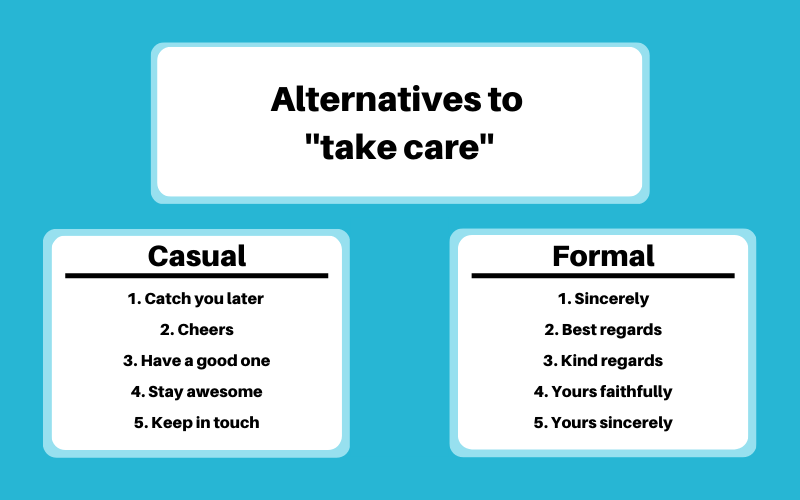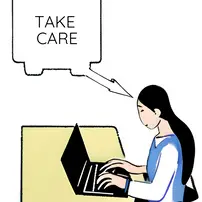Have you ever wondered if using the phrase “take care” in an email is cool or uncool? You’re not alone! In this guide, we’ll explore whether it’s appropriate to use “take care” in emails, its professionalism, alternatives, and when to use it. Plus, we’ll share sample emails to help you nail the perfect sign-off. Let’s dive in!
Can I write “take care” in an email? 🤷
Absolutely! But remember, context is key. “Take care” is a friendly, warm sign-off that works well in casual emails or when you’re writing to someone you have a closer relationship with. However, it might not be the best choice for more formal emails. It’s essential to strike the right balance based on the tone of your email and your relationship with the recipient.
Is it professional to write “take care” in an email? 🎩
The answer depends on the email’s tone and the recipient. If you’re emailing someone you know well or have an informal relationship with, “take care” is perfectly fine. However, for formal emails, consider using more professional alternatives like “Best regards” or “Sincerely.”

What are some formal alternatives to “take care”?
There are numerous alternatives to “take care” that convey varying levels of formality and warmth. Choosing the right sign-off for a professional email depends on the tone, purpose, and context of the message. Here are some alternatives to consider:
1. Sincerely – A classic closing that suits most professional emails, particularly when the sender doesn’t have a close relationship with the recipient.
2. Best regards – A polite and friendly sign-off that can be used for both formal and informal professional emails.
3. Kind regards – Similar to “best regards,” this closing is appropriate for a wide range of professional emails.
4. Yours faithfully – Typically used in formal correspondence when the recipient’s name is unknown, such as a cover letter.
5. Yours sincerely – A more personal closing that is appropriate when the recipient’s name is known, often used in response to a previous email.
6. Warm regards – A friendly and warm closing is suitable for casual professional emails, particularly when the sender has an established relationship with the recipient.
7. Best wishes – A slightly more personal and warm sign-off that can be used when the sender knows the recipient reasonably well.
Always take the time to consider the context of the email and the nature of your relationship with the recipient to choose the most suitable closing.
What are some casual alternatives to “take care”?
1. Catch you later – A relaxed and informal way to say goodbye, usually among friends or acquaintances.
2. Cheers – A versatile sign-off that’s friendly and casual, often used in the UK and Australia.
3. Have a good one – A positive and casual way to wish someone well as you say goodbye.
4. Stay awesome – A fun and upbeat closing that encourages the recipient to keep being their best self.
5. Keep in touch – A warm and friendly way to encourage staying connected, especially if you don’t interact with the person regularly.
To whom can I say “take care” in an email?
As mentioned earlier, “take care” can be used in emails to recipients with whom you have a close working relationship or personal connection. Some examples of when it’s appropriate to use “take care” include:
● Emailing a colleague or coworker with whom you have a friendly relationship.
● Sending a message to a client with whom you’ve developed rapport and trust.
● Corresponding with a mentor, friend, or family member in a professional setting.
When in doubt, consider the nature of your relationship with the recipient and the tone of your email to determine if “take care” is an appropriate closing.
Sample Emails with “Take Care”
Here are two sample emails using “take care” as a sign-off:
Sample Email 1: Catching up with a friend
Hi Alice,
It’s been a while since we last caught up! I hope everything is going well for you and your family. I saw your recent vacation pictures on Facebook, and it looks like you had a blast! Let’s catch up over coffee sometime soon.
Take care, John
Sample Email 2: Informal email to a colleague
Hey Mark,
Just wanted to let you know that I’ve completed the report you requested. I’ve attached it to this email. Let me know if you need any changes or have any questions.
Take care, Jane
Conclusion
In conclusion, it’s crucial to consider the context and the relationship with the recipient when using “take care” in a professional email. While it’s generally acceptable in casual and friendly settings, it may not be suitable for more formal situations or when communicating with someone you don’t know well. By considering the alternatives and choosing the appropriate closing, you can ensure that your email remains professional and effective.
For more tips and examples on crafting professional emails, visit Copy-Paste Emails.









